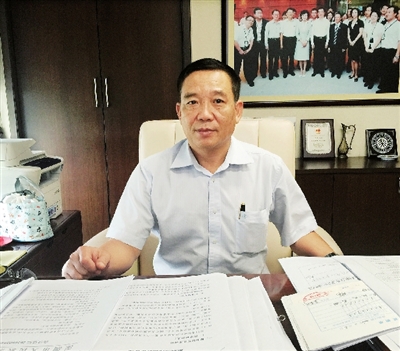
Ye Yang Photo by Zhang Qian
Zhang Qian
zhqcindy@163.com
Hundreds of curators, representatives and researchers from all around the world are gathering in Shenzhen to attend the UNESCO High-level Forum on Museums. One of their stops in the city is the Shenzhen Museum.
The director of the Shenzhen Museum, Ye Yang, had an exclusive interview with the Shenzhen Daily before the forum opened and talked about the history of the Shenzhen Museum and his point of view that the city is in need of more museums in number and variety for its residents.
Under the Shenzhen Museum, there are four existing exhibition halls and another two, including a science hall and the Xiantouling historic site, are under construction.
“Though the modern Shenzhen is a rather young city with only 35 years of history since the city was founded, the human history of this area goes back to as early as 7,000 years ago and we need more museums to show the diversity of life and culture here,” said the director.
Ye was one of the first archaeologists sent by the country to assist Shenzhen’s exploration of historical and cultural relics in the early 1980s after he graduated from Peking University with a degree in archaeology.
“When the Central Government decided to set up the Shenzhen Special Economic Zone, it also required the municipal government to build a museum to tell the history of the city and so started the very beginning of the Shenzhen Museum in 1981,” said the director.
It was not until 1983 that a digging and an array of systematic work were initiated to “check out” the history of this area.
After a few years’ research and collecting historical relics, the Shenzhen Museum was opened in 1988, exhibiting what the archaeology team had discovered throughout the previous years and other antiques and artifacts brought from other areas in China.
The research team had discovered antiques and artifacts from almost all of the dynasties throughout China’s history, but it was also challenging work for the researchers and archaeologists since the city was developing fast and the dig sites were quickly being covered up by urban construction.
After 20 years of service, the old exhibition building for the Shenzhen Museum was replaced by a larger new hall near the Shenzhen Civic Center in 2008.
Shenzhen was the first city to open its museums to the general public for free in China in 2007, one year before the country decided to have free entry at all public museums across the country.
“Shenzhen wanted to raise public awareness to highlight the importance of museums as a means to learn about an area’s history as well as the people who lived there, so we decided to open our museums for free,” said the director.
However, there were also problems when the museums began to be free to the public. One was that people would go inside the museum only to enjoy the pleasant temperature during hot summer days. Second, a large number of residents would form long queues to enter the museum during public holidays.
“Though we have these problems, we still insist that museums should be free to residents because it encourages more people to learn the history of the city they live in,” said Ye.
During the interview, the director also talked about the differences between museums in China and the ones in Western countries.
Ye analyzed that the concept of the museum was introduced to China from the West. Though Chinese people like to collect interesting and valuable objects from history, they tend to keep them private and do not consider displaying them to the public. So China started to develop its own museums at a later stage.
However, because the museums were started much later than the ones in the West, the Chinese museums have the advantage of learning from other countries while preserving their own characteristics.
What’s more, the public museums in China receive considerable funds from the government for the purpose of raising the general public’s sense of admiration for the country’s history. With financial support, public museums in China are expanding rapidly, especially over the past 10 years, said Ye.
But Chinese museums still have a long way to go, especially in terms of museology research and funding. “I think we are in urgent need of professionals who can help with research. As well, we need more funding to aid in collecting more artifacts, including historical relics that are being taken away overseas,” said Ye.
Editor: Jane Chen